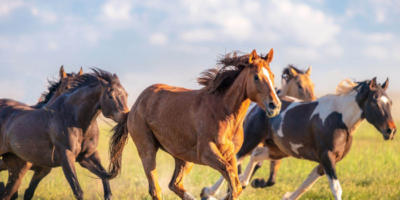Horses have been an integral part of human history, culture, and civilization for thousands of years. These majestic creatures have not only been a means of transportation and labor but have also captured our imagination and hearts with their grace, power, and beauty. The journey of the horse from its early days to the diverse breeds we see today is a fascinating story of evolution, domestication, and human ingenuity. Discover the latest horse racing tips and predictions on France Cheval Turf. Get expert insights and analysis to help you make informed bets.
The History of Horses
The history of horses dates back to over 50 million years ago with the dawn of the small, dog-sized Eohippus, or “dawn horse,” which roamed the forests of North America. Over millennia, through a process of natural selection and adaptation, Eohippus evolved into larger and more efficient forms, leading to the modern horse, Equus ferus caballus.
Horses were first domesticated around 4000 BCE on the steppes of Central Asia. This event marked a significant turning point in human history. The domestication of horses revolutionized agriculture, warfare, and transportation. Early humans recognized the potential of horses for pulling plows, chariots, and carts, which increased productivity and efficiency in farming and trade.
The Role of Horses in Human Civilization
Throughout history, horses have played a pivotal role in shaping civilizations. In ancient times, horses were essential in warfare, providing speed and mobility that transformed military strategies. The cavalry became a dominant force on the battlefield, with legendary horse-mounted warriors such as the Mongols, Huns, and medieval knights leaving indelible marks on history.
Horses also played a crucial role in exploration and expansion. They were vital to the conquests of Alexander the Great, the expansion of the Roman Empire, and the exploration of the New World. In the American West, horses were indispensable to cowboys, settlers, and Native American tribes, symbolizing freedom and the spirit of adventure.
The Diversity of Horse Breeds
Today, there are over 300 recognized horse breeds, each with unique characteristics, histories, and purposes. These breeds can be broadly categorized into three types: light horses, heavy horses, and ponies.
- Light Horses: These breeds are known for their speed, agility, and endurance. They are often used for riding, racing, and light draft work. Notable examples include the Arabian, Thoroughbred, and Quarter Horse. Arabians are known for their endurance and stamina, Thoroughbreds for their speed and racing prowess, and Quarter Horses for their versatility and quick bursts of speed.
- Heavy Horses: Also known as draft horses, these breeds are large, strong, and capable of pulling heavy loads. They were historically used for plowing fields and hauling goods. Famous heavy horse breeds include the Clydesdale, Shire, and Percheron. Clydesdales are known for their striking appearance and strength, Shires for their size and power, and Percherons for their versatility and endurance.
- Ponies: These smaller breeds are known for their strength, intelligence, and friendliness. Ponies are often used for children’s riding, driving, and as companion animals. Examples include the Shetland Pony, Welsh Pony, and Connemara Pony. Shetland Ponies are hardy and strong despite their small size, Welsh Ponies are known for their versatility and friendly nature, and Connemara Ponies for their agility and endurance.
The Enduring Bond Between Humans and Horses
The bond between humans and horses is profound and enduring. Horses have not only been work partners and companions but have also inspired art, literature, and mythology. The mythical Pegasus, the faithful steed of knights, and the cowboy’s trusted companion all underscore the deep connection we share with these magnificent animals.
In modern times, horses continue to be cherished for their beauty, intelligence, and spirit. They are valued in sports such as dressage, show jumping, and racing, as well as in therapeutic settings where their gentle nature helps heal and comfort people with physical and emotional challenges.
Conclusion
The story of horses is intertwined with the story of humanity. From their early days on the plains of prehistoric America to their current roles in sport, therapy, and companionship, horses have remained steadfast partners through the ages. Their rich history and diverse breeds reflect their adaptability and the deep respect and admiration humans have for these majestic equines. As we continue to explore and appreciate the world of horses, we honor a legacy that has profoundly shaped our civilization and enriched our lives.





















Comments